EE TV review: a decent set-top box with too many strings attached

EE has evolved rapidly since it became a household name two years ago after switching on the UK's first 4G mobile network. Today, it's more than just a carrier, with a home broadband business and a selection of own-brand mobile devices, among other things. And now, EE's decided to turn its hand to home entertainment, having recently launched the EE TV set-top box. Free and available only to customers of EE's mobile and broadband services, it's essentially a Freeview DVR with a few tricks up its sleeve. Tying into EE's primary focus on mobile, one of the fancier features is the box's ability to stream live and recorded video to multiple smartphones and tablets simultaneously. But is a free DVR with a couple of advanced capabilities enough of an incentive to get you signed up for the required services (which is sort of the point)? Not really, no.
To be a leading telecoms brand, you need to get involved in the four main connected utilities: landline, broadband, mobile and TV. Virgin Media, TalkTalk and now EE offer the full quartet, but Sky and BT aren't far behind, with the mobile-shaped holes in their lineups looking like they'll be filled soon enough. Vodafone's planning an aggressive expansion next year too, starting with its own broadband service and later, some form of TV offering. The issue EE has right now is that it's competing with established TV providers, and while its set-top box might have some unique features, there's nothing you can actually watch on it you can't find easily elsewhere.
Content

When it comes to available content, EE TV doesn't have a lot to brag about. It's a Freeview player, feeding off the 70-plus TV channels and 25-odd radio stations that are broadcast subscription-free across the UK. EE TV doesn't cost anything itself, so the fact that it doesn't include access to premium channels isn't exactly surprising. The only problem with that, though, is that the vast majority of people already have Freeview at home, whether it's built into their TV or picked up by a box sitting beneath it. And, I imagine those who don't currently receive Freeview are unlikely to sign mobile and home broadband contracts just to get hold of EE's set-top box.
Rival telecoms Sky, Virgin Media, BT and TalkTalk are either broadcasters in their own right, or at least offer a wide range of channels you simply won't find on Freeview. You have to pay for the privilege, of course, but in that sense, all four are true TV providers. EE, on the other hand, is merely offering a piece of hardware as a bonus to customers who sign up for its mobile, broadband and, by default, landline services. The conundrum, then is, by not attaching a value to something, how are you to judge its worth? Now, EE can't rightly charge a subscription for its Freeview box, but with no premium content partners, it's completely reliant on the perceived value of its box's feature set.
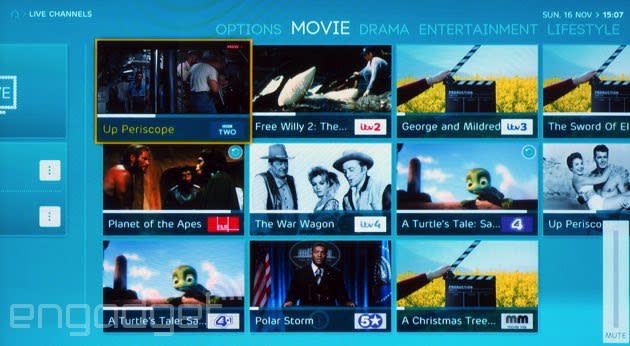
I get that the company's trying to mould a product ecosystem, but there's one thing I'm certain of: EE isn't a "quad-play" provider just yet. EE TV isn't a service. It's a DVR, and one you can't even buy -- more of a "thank you" for choosing EE as your mobile and broadband supplier. Needless to say, I can't quite figure out the strategy here, but maybe there isn't one to miss. Perhaps it's just a case of doing something because you can.
In addition to live TV, EE's box can also tap into various catch-up, on-demand and similar services via apps. Pickings are unfortunately slim at the moment, though, with BBC iPlayer, BBC Sport, Demand 5, YouTube and Wuaki.tv as the only notable launch partners. Better than nothing, I guess, but hardly something to get excited about when familiar names such as ITV Player and 4oD aren't even on board yet. I mean, EE's own movie-rental service EE Film (available on mobile devices through desktop browsers) isn't accessible through the box. Also, after speaking with the company, it doesn't sound like there are any immediate plans to port over EE Film, either. Instead, users are invited to try Wuaki.tv, a competing service.
EE has said that in time, more apps will begin populating the store. That's great and all, but for now, EE TV is by no means a one-stop shop for all your viewing needs. If you have any form of connected home-entertainment gear -- a smart TV, games console, set-top box, Roku, Now TV, Amazon Fire TV, Chromecast, et cetera -- then you already have access to so many content portals that EE's selection is irrelevant in comparison. It's also worth pointing out that YouView boxes (retail or BT-/TalkTalk-issued) have plenty more apps, including Netflix, and some of the same basic DVR features as EE TV. It's not clear exactly how EE intends to bulk out the app catalogue, but really it's got one of two options: Pay big names like Netflix and Amazon Prime Instant Video to get on board, or employ the riskier tactic of hoping they see enough value in EE TV that they invest in development themselves.
Hardware
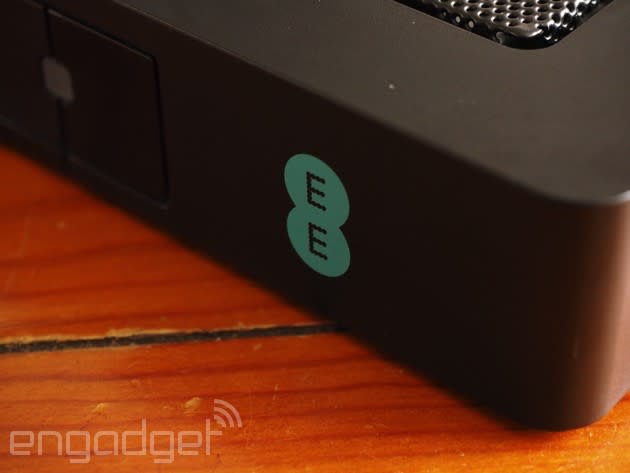
I'll spare you all the gritty details of what's inside the Netgem-made set-top box, mainly because the clock speed of its processor doesn't tell you anything about what it can actually do. One component that is worth mentioning, however, is the 1TB hard drive, which EE says is capable of storing approximately 600 hours of standard-definition video or half that of HD content. With dimensions of 200 x 200 x 38mm, EE TV is quite a neat little box that should slot nicely into even the most minimalist of living room TV setups. On the flip side, my TV stand is a cavernous mess of consoles, speakers and other equipment, and yet I easily found a home for the additional box, though I'm not sure my Xbox 360 appreciates its new hat.
If you happen to have a dedicated sound system, chances are you'll be able to plug EE TV into it, thanks to a mix of digital and RCA audio-out ports on the back of the box. These are joined by a coaxial-in port for plugging in your aerial, and coaxial-/HDMI-out ports for hooking the thing up to your TV. There's also a small SCART connector, should you need it, but you'll have to ask EE to send you a free cable as it's not included in the packaging. To get the box online, you can use an Ethernet hardline or the built-in dual-band 802.11b/g/n WiFi.
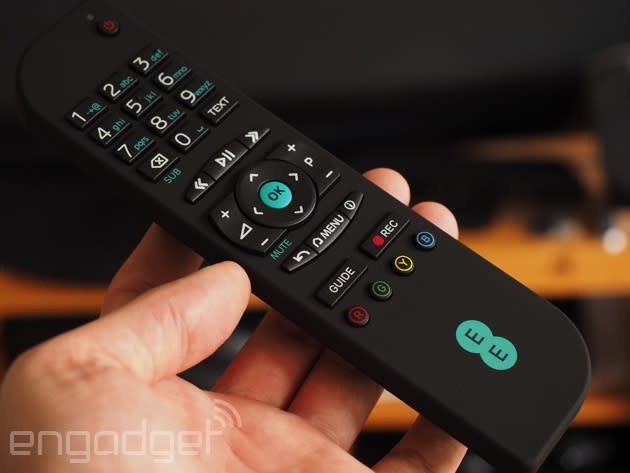
Now, unless you're seriously picky about the stuff that fills your entertainment centre, I doubt the outward appearance of EE TV is something you're going to care much about. That being said, it's not unattractive as far as small, square boxes go. It's crafted from a combination of shiny and matte black plastics, which gives it a pleasant visual texture that'll be familiar to anyone who owns an Xbox One or PS4. The only other design accents are an EE logo and relatively large light (which radiates green when on and red on standby) on the front of the box, as well as a wide, square grille on top that lets you peek through at the components.
The EE TV remote also has a certain amount of character to it. Its corners are rounded and square in equal measures, and it's bound in a textured, rubbery plastic. While this cladding makes it look nicer than your average remote, I get the impression it would end up noticeably scuffed if it spent a few months being pushed around my coffee table. All the important buttons are clustered around a central directional pad, and I only mention the layout because I found myself navigating it like a touch-typist after just a couple of days.
User Experience
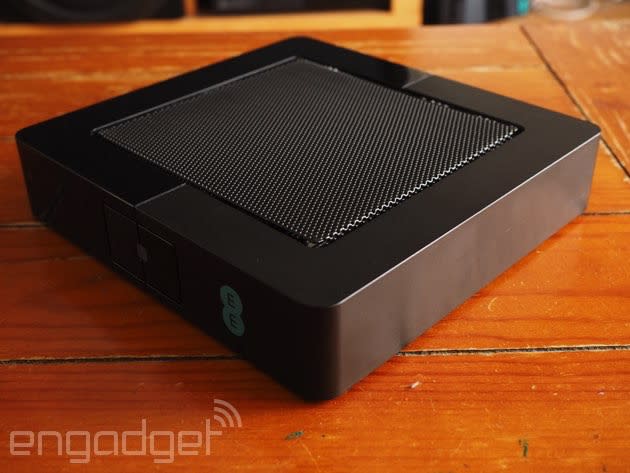
When it comes to actually using EE TV on a day-to-day basis, you've kinda gotta take the rough with the smooth. In some situations, it functions better than you might expect it to, and then it goes and disappoints elsewhere. The initial setup process, for one, is extremely quick and easy. When you first switch the box on, you connect it to your EE router via WiFi or Ethernet, then set up a PIN for the child-safety measure. If you choose to enable this, adult channels, anything marked with a parental guidance notice and content recorded after the 9 PM watershed will be locked to the little ones. Following these steps, you can choose to set up the "Replay" recording feature (more on this later) right off the bat, or not, and then you're good to go.
EE says the set-top box's main menu was designed with mobile functionality in mind, and it's true that the EE TV apps look almost identical to the TV UI. The interface employs the same "content-first," image-driven approach that's common to entertainment-focused devices and services nowadays -- the Xbox One and BBC iPlayer UIs are a couple of examples that instantly spring to mind. EE's put its own little twist on things, of course, with the brand's familiar teal colour scheme, soft font and simple icon style permeating every inch of the UI.
The main menu itself consists of four "panes," for lack of a better word: On Demand, Live TV, Recordings and Replay (in that order). The On Demand section is where you hop into apps like Wuaki.tv, but Live TV is always the first thing you see when you turn the box on. It consists of a live feed of the last channel you were watching, flanked on two sides by smaller, static frames that tell you what's currently airing on the five primary terrestrial channels. Icons off to the right of this arrangement let you load up the electronic programming guide (EPG) -- which the "Guide" button on the remote does from anywhere. From here, you can also check out what's on the radio or step into the live-channel sorting office. From here, you can view all channels in order, or sort them by popularity or content type, which is handy if you're specifically looking for movies, sports or kids programming, as a few examples.
The Recordings and Replay panes are laid out in a similar way. Recently recorded content is given pride of place in dedicated windows, but there's always a deeper menu beyond for sorting and categorizing. It's all very easy to understand, and is cleverly built so you can always filter and find the content you want in only a few "clicks." What's more, it's impressively fast, meaning you can fly between panes without any noticeable input lag. It slows down slightly in the deeper sorting menus, but not to the extent that it even approaches frustrating. All sounds good so far, right? Well, as slick as the menu system is, you're almost certainly going to be spending much more time flicking through the EPG, cruising for something to watch. And, unfortunately, the EPG is so sluggish it drives me to distraction.
Pressing the Guide button on the remote brings up the EPG instantly, but it then takes a second or two to populate the listings for the eight channels in the grid. Page down, and you have to wait another second for those listings to load, and so on. This kind of downtime is almost more annoying because the rest of the user interface is so fast. I have no idea why this information isn't constantly being cached in the background so the full directory is available whenever you might want it. And if there's a technical reason this can't be done, I don't believe it. When you are watching a channel, you can bring up mini EPGs by prodding the directional pad. One pops up on the left side of the screen, and shows you what's on other channels, while the other rises from the bottom of the screen and tells you upcoming programming on the channel you're watching. Both of these are fully populated straight away, making the slow, main EPG even more of a curiosity.
There are plenty of other good and bad points to highlight about the EPG. It consumes the screen when you summon it, but it's semitransparent so you can still see the channel you're currently on through it, which is a nice touch. The programme details pop-up, like the EPG itself, takes a second to load when you hit the information button on the remote, but here you'll also find when subsequent episodes of that particular show are being broadcast over the next seven days. You can schedule recordings or reminders from within this overlay, which is charmingly intuitive. In fact, anywhere you might conceive the record command to have an effect, it does. The first option that presents itself, however, is to record the entire series of a programme, which means you're always another button press away from just recording that one episode.
Advanced features

As EE TV is a DVR, the idea is that you'll do more than just watch TV on it, such as recording content to the box for consuming it whenever you fancy. You can pause and rewind live TV, of course, but the box's main selling points revolve around its advanced features. Like the general user experience, though, these snazzy functions come with their own limitations.
Replay
Replay is a really neat feature that lets you select up to six channels to record 24/7. (Well, almost, as for some reason Replay won't record anything aired between 3 AM and 5 AM in the morning.) You can tell the box to keep the last six, 12, 18 or 24 hours of content before it starts deleting the oldest recordings to make room for the new. With Replay disabled, all four of the box's tuners are available to you, meaning you can record up to four different channels at once. Switch the feature on, and two of those tuners are reserved for Replay, while the other two are still free for you to record up to two other channels at the same time. Replay content has its own section in the main menu, making it all easily searchable, but you can also cycle through past broadcasts in the EPG and launch recordings from there. This is particularly handy if you've missed the start of something you want to watch, because you can simply jump to the beginning of the broadcast.
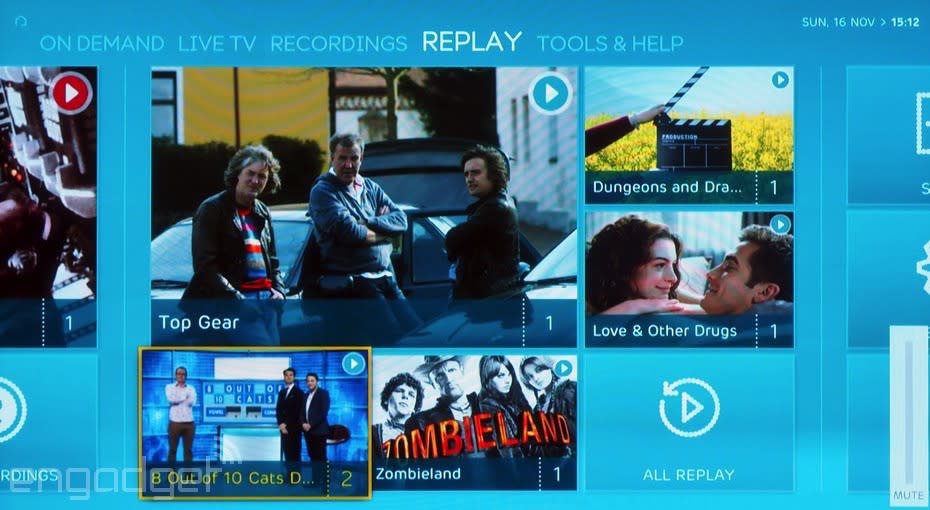
There's no denying this is a great feature, and one you won't find on other set-top boxes, but it's more of a half-feature due to the limited selection of channels you can select to "Replay" -- in other words, it's not available on every Freeview channel. In fact, only the well-known terrestrial providers are supported, with the entire channel selection as follows:
BBC 1/2/3/4
CBBC/CBeebies
BBC News & BBC Parliament
ITV1/2
Channel 4/E4/Film4/More4
Channel 5
Now, I get that these are all popular channels, but the limitation is still frustrating to me. I'd like to revisit some of the budget flicks that air on Movie Mix at 2 AM on a Wednesday morning, but I can't. There is technical reason for this, though, as EE explained to me. Freeview channels are broadcast in groups, known as multiplexes. What Replay does is record a whole multiplex, which only uses one tuner, and then splits the individual channels out at the box level. Thus, you can only record two different multiplexes at any one time, so EE chose to offer the most popular "as a starting point." Even with this understandable explanation, though, somehow this limitation feels like a broken promise. Oh, and you also can't record any HD versions of the channels listed above. This, too, makes sense, as EE needs to limit how much hard drive space Replay content occupies. Still, more fine print.
What I find most frustrating about the Replay feature is that recordings can't be saved permanently. If Replay captured a particularly good film you wouldn't mind watching again, for example, there's no way to rescue it from being deleted when the next cycle rolls around. You just have to hope it's being aired again soon so you can schedule a proper recording.
Mobile streaming
EE TV's most-hyped feature is the ability to stream video to up to four devices at once, though one of these will always be your main TV. The EE TV apps for Android and iOS look and behave like the big-screen UI. In this sense, whatever tablet or phone you're using becomes an EE TV in its own right. You can schedule recordings through the app, use your phone as a secondary remote and "fling" anything you're watching on a mobile device to the TV in one swipe. It's extremely hard to pick fault with the mobile integration, because everything just works flawlessly. Give the app a "fling" command, for example, and the video source will jump from your tablet to the TV in the blink of an eye.
I managed to persuade a few friends to come round and help me put the multi-screen feature through its paces. Two tablets, one phone, one person on the TV remote and one goal: to break it. I had everyone jumping from recordings to live TV -- pausing, rewinding, fast-forwarding, flinging, channel surfing and doing everything in between. And, apart from very short buffering times when switching between video sources, which is completely understandable, the system never faltered once.
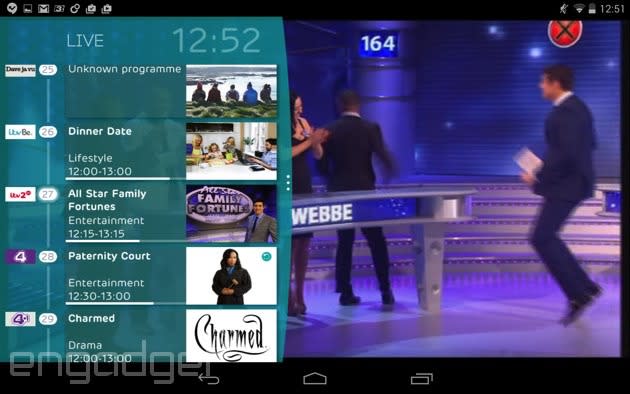
The truth is, I don't have much use for the feature, but I can imagine there are a few families out there fighting for the remote right now that would appreciate it. Everyone going their separate ways to huddle around small screens might not be the most family-friendly activity, but at least everyone gets the same, smooth experience. Like everything else, though, testing out the feature led me to discover one annoying restriction. Streaming HD content, whether live or recorded, is only supported on devices that can process the high-def Freeview MPEG-4 signal directly, none of which I own (most newish Apple hardware does, by the way). Also, I know the multi-screen functionality is intended for getting the most out of your mobile devices, but I don't see why EE couldn't have built an app for PCs and Macs, too. I'm told this is under consideration.
While EE TV is the only set-top box on the market that can stream to four different devices, Sky and Virgin do have comparable services, with the benefit of these being you don't have to be connected to the same WiFi network as your box at home. The Sky Go app allows up to two devices (including computers) to stream video over any WiFi or cellular data network -- it's pulling content from the cloud and not your specific set-top box, you see -- or up to four if you pay the piper for Sky Go Extra. You can't get at any of the recorded content on your Sky+ box, but you do have the ability to access premium channels and tons of on-demand content. Virgin Media's TV Anywhere service does exactly the same thing, though the selection of channels and on-demand content is different, and you can only register a maximum of two devices. So, yes, EE TV is the only box that will stream recorded video to mobile devices, but the functionality is far from revolutionary, and you can get similar and arguably better services from other providers.
Wrap-up

If you look at EE TV merely as a product, then it's got a couple of cool features that make it better than your average DVR. The user interface is well-designed and really fast to navigate, though thinking about the lethargic EPG is enough to keep you awake at night. Replay is something I've used more than I expected to, especially when I've missed the start of a broadcast, but I can't help but want the feature to be available to all channels, not just the ones EE's preselected. The mobile-streaming functionality deserves praise because it works fantastically well. Despite various technical limitations EE doesn't advertise, I can see why people might want to buy this DVR to upgrade their Freeview experience. And therein lies the fundamental problem: You can't just buy it.
I was confused about the proposition before I even started using EE TV, and I have to say I still just don't get it. I don't see how people are expected to get excited about the product when it's so inaccessible. You have to be a mobile customer of Orange, T-Mobile or EE (contract or PAYG) and sign up for an EE broadband contract, which means you also need an EE landline. Even if you're an existing customer who fits these criteria, you have to sign up for a new 18-month broadband contract to become eligible to receive a box. I understand the premise: EE TV has some cool features, and being "free," it's an incentive for people to buy into EE's service ecosystem. There's a further lure for mobile data guzzlers, too, as anyone on a 4G EE plan that signs up for broadband gets an extra 10GB or 20GB of data, depending on their current tariff.
But, really, does anyone care? EE could throw in a lottery ticket, a pair of sunglasses and a calculator, but none of that is going to stop you from looking at what you're going to be spending each month for your landline, mobile and broadband. Don't get me wrong; EE TV is a capable piece of hardware that's being given away for free, but at what cost? I think consumers are too savvy to pay attention to this dangling carrot, instead focusing on what contracts are going to cost them in the long run. And, after all, it's just a fancy Freeview DVR, not a conduit for any kind of premium content you can't get elsewhere. The box itself is a satisfactory piece of hardware, but the hoops you have to jump through to get one just don't seem worth the hassle, unless all the required EE services happen to be the best value option for you.
























































